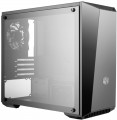Dust filter
The presence of a special filter in the housing to prevent dust from entering. Without such a filter, dust settles on the system elements; Radiators are especially susceptible to this; they also lose their efficiency by becoming clogged with dust. If you have
a dust filter, you have to clean not the “filling” of the PC, but the filter element itself, which is much simpler and more convenient.
Compartments for dust filters can be located on
the front panel of the case,
back,
bottom,
top, or
in the side walls. There are also case models with several technological niches for installing dust filters - the combined version assumes the presence of such compartments on several sides of the case at once.
Liquid cooling support
This feature is indicated for housings that normally allow the installation
of liquid cooling systems(LCS). Such systems are extremely efficient, but complex and expensive, so they are mainly used in high-performance PCs, for which traditional coolers are no longer enough. Note that theoretically, liquid cooling can be installed in almost any case; however, if support for such cooling is not initially provided in the design, this can be very difficult. So if you initially plan to use LSS, you should choose a case for which support for this function is directly claimed.
Liquid cooling (rear)
The size of the seat for the water cooling system provided on the back of the case.
In cases with CBO support, water cooling radiators are installed in the same slots as traditional fans. In other words, either a fan (fans) or a CBO radiator can be installed on the same seat. The size of the seat under the CBO is indicated by one number — the length (on the larger side); the width can be determined based on these data. The fact is that modern CBO radiators usually use fans of one of the standard sizes — 120 mm or 140 mm; and if there are several such fans, they are arranged in a row. As a result, the length of the radiator turns out to be a multiple, and the width is equal to one of these numbers: for example, 280 mm is 2x140 mm with a width of 140 mm, and 360 mm is 3x120 mm with a width of 120 mm.
Note that in this case, the same nuances are relevant as for air cooling: a larger fan takes up more space and costs more, but it is considered more advanced, as it can work efficiently at a lower speed — and this reduces the level of noise and vibration.
Liquid cooling (front)
The size of the seat for the water cooling system provided on the front side of the case.
In cases with CBO support, water cooling radiators are installed in the same slots as traditional fans. In other words, either a fan (fans) or a CBO radiator can be installed on the same seat. The size of the seat under the CBO is indicated by one number — the length (on the larger side); the width can be determined based on these data. The fact is that modern CBO radiators usually use fans of one of the standard sizes — 120 mm or 140 mm; and if there are several such fans, they are arranged in a row. As a result, the length of the radiator turns out to be a multiple, and the width is equal to one of these numbers: for example,
280 mm is 2x140 mm with a width of 140 mm, and 360 mm is 3x120 mm with a width of 120 mm. In general, the size of the front radiator of
240 mm or less is considered relatively small, 280 mm — medium,
360 mm — large, and in some models it reaches
420 mm or even more.
Note that in this case, the same nuances are relevant as for air cooling: a larger fan takes up more space and costs more, but it is considered more advanced, as it can work efficiently at a lower speed — and this reduces the level of noise and vibration.
Liquid cooling mounts
The total number of places for water cooling systems provided in the case, in other words, the largest number of CBO radiators that can be installed in the case. Such radiators are usually placed one at a time on the side of the case, so several radiators are most often located on different sides: for example, 3 places for CBO can be located at the back, top and front.
When estimating the number of seats (of all types), it should be taken into account that CBO fans and radiators usually use the same seats.

